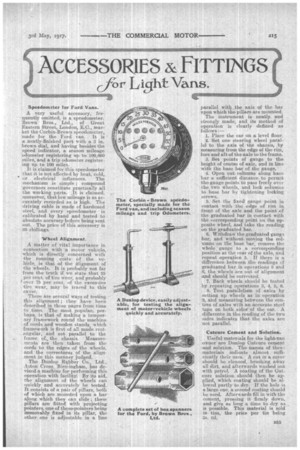ACCESSORIES &FITTINGS
Page 19

If you've noticed an error in this article please click here to report it so we can fix it.
r Light Vans.
Speedomtter for Ford Vans.
A very useful accessory, frequently omitted, is a. speedometer. Brown Bros., Ltd., of Great Eastern Street, London, E.C., market the Corbin-Brown speedometer, made for the Ford van. It is a neatly-finished part with a 3 rn. brown dial, and having besides the speed indicator, a season mileage odometer registering up to 100,000 miles, and a trip odometer registering up to 100 miles.
It is claimed for this speedometer that it is not affected by heat, cold, or electrical influences, The mechanism is simple ; compound governors constitute practically all the working parts. .It is claimed, moreover, that low mileage is as accurately recorded as is high. The driving cable is made of hardened' steel, and every speedometer is calibrated by hand and tested to absolute accuracy before being sent out_ . The price of this accessory is 65 shillings.
Wheel Alignment.
• A matter of vital importance in. connection with .a motor vehicle, which is directly concerned with the running costs of the yehide, is that of the alignment of the wheels. It is probably not far from the truth if we state that 25 per cent, of tire wear, and probably 4 over 75 per cent. of the excessive tire wear, may be traced to this cause.
There are several ways of testing this alignment ; they have been , &Scribed in those pages" from tinn.e to time. The most popular, perhaps-, is that of making a ternporL. ary framework round the.. machine of cords and wooden stands, which framework is first of all made reetangular; and set parallel to the frame Of.,, the chassis. Measurements are then taken from the cords to the c-dges •of the wheels, and • the correctness of the alignment in this manner judged. The Dunlop lin,bber Ltd., Aston Cross, Birmingham, Co.,s devised a machine for performing this operation with facility. • By its aid, the alignment of the wheels can quickly and accurately be tetsted. It consists of a pair of pillars, both
of which are mounted upon a bar alongwhich they can slide ; these pillars are fitted with projecting pointers, one of thesepointers being immovably fixed in its pillar, the other one is adjustable in a line parallel with the axis of the bar upon which the pillars are mounted.
The instrument is neatly, and strongly made, and its method of operation is clearly defined as f allows :— 1. Place the ear on a level floor.
2. Set one steering wheel parallel to the axis of the ehaSsis, by measuring from the edge of the rim, fore and aft of the axle to the frame..
3. Set points of gauge to the height. of centre of axle, and in line with the base bar of the gauge.
4. Open out columns along base bar a sufficient distance to permit
the, gauge points to pass freely OVer the two wheels, . and lock oolumno to base bar by tightening locking screws.
5. Set the fixed gauge point in contact with the edge of rim in
front of the axle and the point oi the graduated bar in contact with the corresponding point on the op-. posite wheel, and take the reading on the graduated bar.
6. Withdraw the graduated gauge bar, and without moving the ex.717
umns. on the base bar; remove the whole gauge to a corresponding position at the rear of the axle, and
repeat operation 5. If there is a difference between the readings of graduated bar in operations 5 and 6, the wheels are out of alignment and should be corrected 7. Back wheels should be tested by repeating operations 3, 4, 5, 6.
8. Test parallelism of axles by setting up wheels as in operation 2, and measuring between the con ' tres of axles with an accurate steel tape on both sides of the. car. A differenbe in the reading of the two sides indicates that the axles are not parallel.
Cutcure Cement and Solution.
Useful materials for the light-van owner are Dunlop Cuteure cement and solution. The names of the.s.7 materials indicate almost • sufficiently their uses. A cut in a cover should be cleaned, brushing aWay all dirt, and afterwards washed out with petrol. A Coating of the Cutcure solution should then be applied, which coating should be allowed partly to dry. If the hole is a. large one, a second coating should be used. Afterwards fill in with cement, pressing it firmly down, and give as Jong a time to dry as , is possible. This material is sold intins, the price per fin being 3$. 60.






















